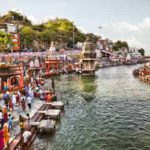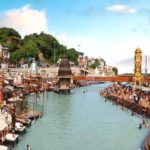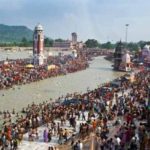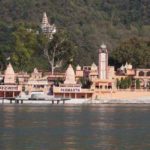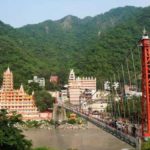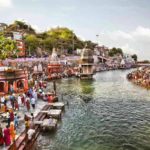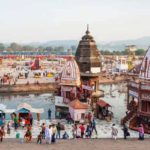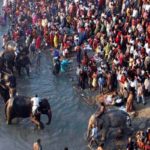Haridwar Kumbh Mela 2021 The Haridwar Maha Kumbh Mela will be held in Haridwar in January 2021. Kumbh is the largest religious congregation that millions of Hindu pilgrims from all over the world celebrate. Haridwar Kumbh Mela 2021 Bathing Dates have already been announced. Haridwar is one of the four Kumbh fair sites and Prayagraj, formerly known as Allahabad, Nasik, and Ujjain, is another. For Hindus, Kumbh is important. Bathing is the main attraction at the fair. Devotees come here and, along with millions of other Hindu pilgrims, take part in bathing. The next Kumbh Mela begins on January 14th, 2021. On 11 March 2021, the first Sahi Snan (Bathing) will be performed. All the Sahi Snan dates and other bathing dates during the Kumbh Mela on auspicious days can be found below. The event will last until April 27th, 2021.
The Kumbh Mela in India is the largest human congregation on Earth and was added on 8 December 2018 to the Intangible Cultural Heritage List. The water of those holy rivers is believed to transform into nectar according to the location of astrological stars. The Hindus wash themselves away in the holy rivers at this festival to give away all their sins. In 2019, as per government reports, Allahabad Kumbh Mela Packages attracted a crowd of 24 million, including 1 million international tourists. A further step closer to redemption is viewed as the Holy Dip at Kumbh Mela. More importantly, in this holy meeting, the participants of this Kumbh Mela were not only limited to India, but to individuals all over the world.
In excess of approx. 2000 years ago, India’s Kumbh Mela was the ultimate event of divinity and drew mass crowds. The reference to Kumbh Mela can be found in King Harshavardhana ‘s territory. It is worth mentioning the defence, sanitation and civic arrangements, along with other facilities. Police guards and other public service departments, such as health, energy, etc., successfully control the crowd. Kumbh mela is the best place for you if you want to see or experience the most sacred way of celebrating Indian culture. There are plenty of accommodation options to take care of all your fair needs with hospitable facilities. In order to prevent eleventh hour rush, however, you are advised to be a little quicker in booking flight / train tickets and accommodation. So, are you ready to be part of the largest gathering on earth in the world, named Maha Kumbh Mela at Haridwar in 2021.
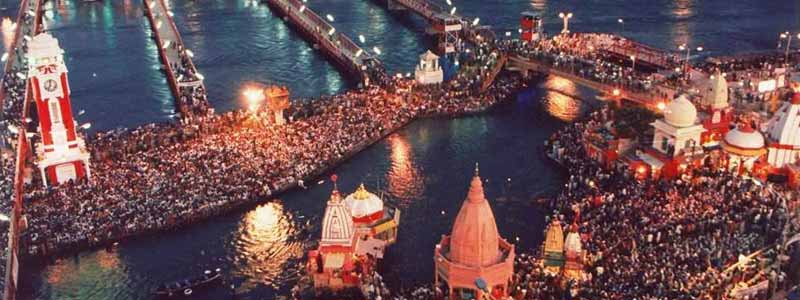
Kumbh & its origins
‘Haridwar’ or ‘Hardwar’ is regarded as one of the Hindus’ seven holiest places (Sapta Puri). Haridwar, along with Ujjain, Nashik, and Prayagraj (Allahabad), is one of 4 sites, according to the Samudra Manthan, where a few drops of Amrit (the elixir of immortality) mistakenly spilled out of the pitcher while being carried by the Celestial Bird Garuda (Eagle). This is expressed in the Kumbha Mela, celebrated in Haridwar every 12 years. Lakhs of pilgrims, devotees, and visitors gather in Haridwar during the Haridwar Kumbh Mela to conduct the ‘holy bath’ on the banks of the river Ganga to wash away their sins and attain Moksha (Pittance). Har ki Pauri is one of the most popular locations in Haridwar, known as “Brahma Kund.” It is where a few drops of Amrit or an elixir of immortality have dropped, and that is why it is known as Haridwar’s most sacred ghaat. It is also the epicentre of the ‘Kanwar pilgrimage’ in which participants’ lakhs collect holy water from the Ganga River and take it through hundreds of miles to dispense it as an offering to ‘shiv lings’ in some of the temples of the most prominent God Shiva.
Hundreds of devotees gather around Har Ki Pauri every evening to give River Goddess Ganga prayers by lighting up diyas and floating them in the river. The entry point of the River Ganga in Haridwar is marked by Har ki Pauri, which translates as “the footsteps of God Shiva.” Haridwar is also famous for “Ganga Aarti” which takes place at Har ki Pauri ghaat every evening and is attended every day by hundreds of tourists. As the number of devotees rises to thousands every day, as it is also the time of the holy bath and offering prayers to gods and goddesses, its significance during Kumbh rises. Sages or pandits give lighted lamps (diyas) during the “Ganga Aarti” and chant vedic mantras along with the ringing of bells to appease life and all on earth to the gods and goddesses. Devotees may also chant mantras and give prayers along with the sages, who are dressed on their forehead in orange ‘dhoti’ and ‘chaadar’ with vermillion coloured ’tilak.’ It is said that during the Kumbh, those who participate in the “Ganga Aarti” remain blessed throughout their lives by gods and enjoy good health, prosperity and remain safe from diseases.
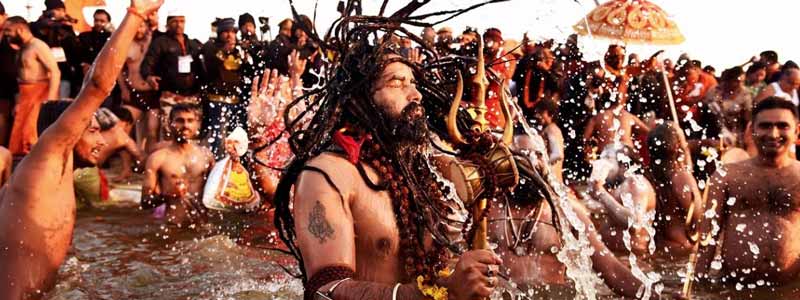
Kumbh Mela 2021 Important Dates
In Haridwar, the forthcoming Kumbh Mela fair will be held. The dates for the Kumbh Mela pilgrimage are decided according to the calendar of Vikram Samvat. Below, the significant bathing dates are given.
On the auspicious occasion of Makar Sankranti, Kumbh Mela 2021 will commence on 14th January. The first Shahi Snan will be held on March 11 and the second and third will take place on April 12 and 14, respectively. And the Haridwar Kumbh Mela 2021 will come to an end on April 27th, with the Shahi Snan.
| Kumbh Mela Dates |
||
|---|---|---|
| 14 January 2021 |
Makar Sankranti |
Snan |
| 11 February 2021 |
Mauni Amavasya |
Snan |
| 16 February 2021 |
Basant Panchami |
Snan |
| 27 February 2021 |
Maghi Poornima |
Snan |
| 11 March 2021 |
Maha Shivratri |
Shahi Snan |
| 12 April 2021 |
Somvati Amamvasya |
Shahi Snan |
| 13 April 2021 |
Chaitra Shukla Pratipada |
Snan |
| 14 April 2021 |
Baisakhi |
Shahi Snan |
| 21 April 2021 |
Ram Navami |
Snan |
| 27 April 2021 |
Chaitra Purnima |
Shahi Snan |
List of Bathing Ghats in Haridwar
- Har Ki Pauri
- Asthi Pravath Ghat
- Subhash Ghat
- Gau Ghat
- Sapth Sarover Kshetra Ghat
- Sarvanand Ghat
- Pantdweep Ghat
- Kangra Ghat
- Roode Bale Wala Ghat
- Ganesh Ghat
- Varagi Camp Ghat
- Sati Ghat
- Daksheshwar Ghat
- Singh Dwar Ghat
- Sita Ghat
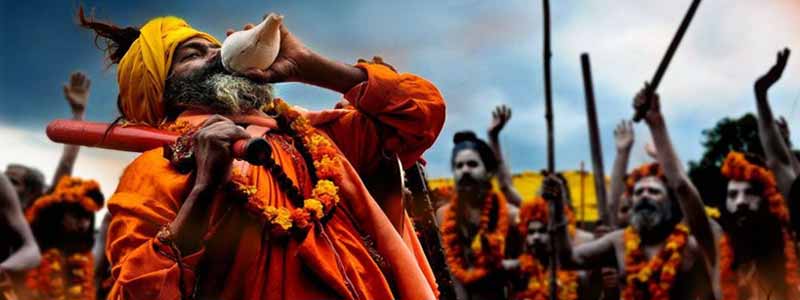
Religious Importance of Kumbh Mela
The festival is the most important religious event for Hindus. Millions of Hindus take part in the celebrations at every Kumbh function. More than 10 million devotees gathered at the site during Kumbh in Haridwar in 2003. To participate in Kumbh, saints, priests, and yogis gathered from all corners of India. Haridwar is considered very sacred since here itself, Ganga reaches the plains from the mountains.
In ancient Vedic scriptures known as the Puranas, Kumbh Mela derives its name from the eternal-the Pot of Nectar. Kumbha means pot or pitcher in the Sanskrit language. ‘Festival’ means Mela. Kumbh Mela, then, means the Pot Festival. Or, in this case, a festival celebrating the nectar pot ‘s arrival.
In the time-honored Vedic literature of India, the ancient origin of Kumbh Mela is mentioned As if it had arisen from the Bygone days of the universe when the nectar of life was jointly created by the semigods and demons. It is said that on the shore of the milk ocean that lies in the celestial area of the cosmos, the demigods and demons gathered. To create the nectar of life, the demigods and the demons made a scheme to churn the milk ocean. They then decided to evenly share the nectar once it was produced.
Mandara Mountain was used as the churning rod for the purpose of churning the milk ocean, and Vasuki, the king of serpents, became the churning cord. The Mandara Mountain started to sink deep into the ocean as the churning started, at which point Vishnu incarnated as a massive tortoise and supported the mountain on his back. They churned the milk ocean for a thousand years, with the demigods at Vasuki ‘s tail, and the demons at his head.
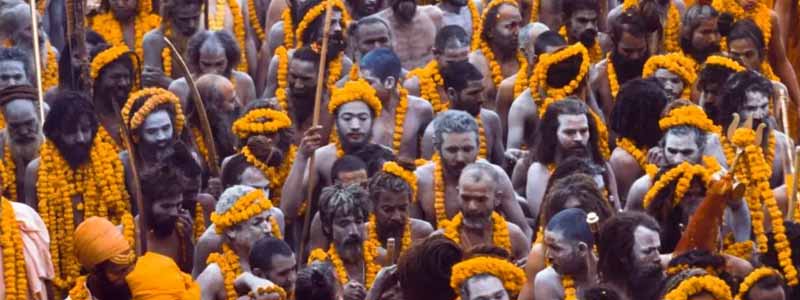
A lethal poison that Shiva drank without being affected was first created by the churning of the milk ocean. A few drops fell from his hands as Shiva drank the poison, and scorpions, snakes, and similar dangerous creatures were locked up. Numerous opulent objects were created after Shiva drank the poison. Second, there was a Surabhi cow that could produce infinite amounts of milk. A white horse named Uccaihsrava as well as a white elephant named Airavata were then made. Then a precious gem named Kaustubha-mani emerged.
Next came the apsaras, beautiful dancing people, and from the milk ocean emerged a host of other marvellous things. Finally, a male person called Dhanvantari appeared, holding in his hands a pot of everlasting nectar. Seeing Dhanvantari with the Nectar Pot, The demigods and demons were both nervous. Fearful of what would happen if the demons drank their share of the nectar of life, the demigods took the pot forcibly.
Fierce combat ensued everywhere the demigods went with the pot of nectar. The demigods concealed it in four locations on earth, Prayag (Allahabad), Hardwar, Ujjain, and Nasik, in an attempt to prevent the nectar from falling into the hands of the demons. A drop of everlasting nectar poured out of the jar at each of the hiding places and fell on the earth. Since then, these four places are thought to have acquired mystical authority.
The demon woman, Mohini-murti, eventually approached the demon. They lost all composure when the demons saw the charming beauty of Mohini-murti. The demons utterly forgot to drink the nectar of immortality when they saw her slender curves, raised breasts, and pleasing smile. While the demons were thus puzzled by Her beauty, Mohini-murti seized the nectar and gave it back to the demigods, who immediately drank it.

